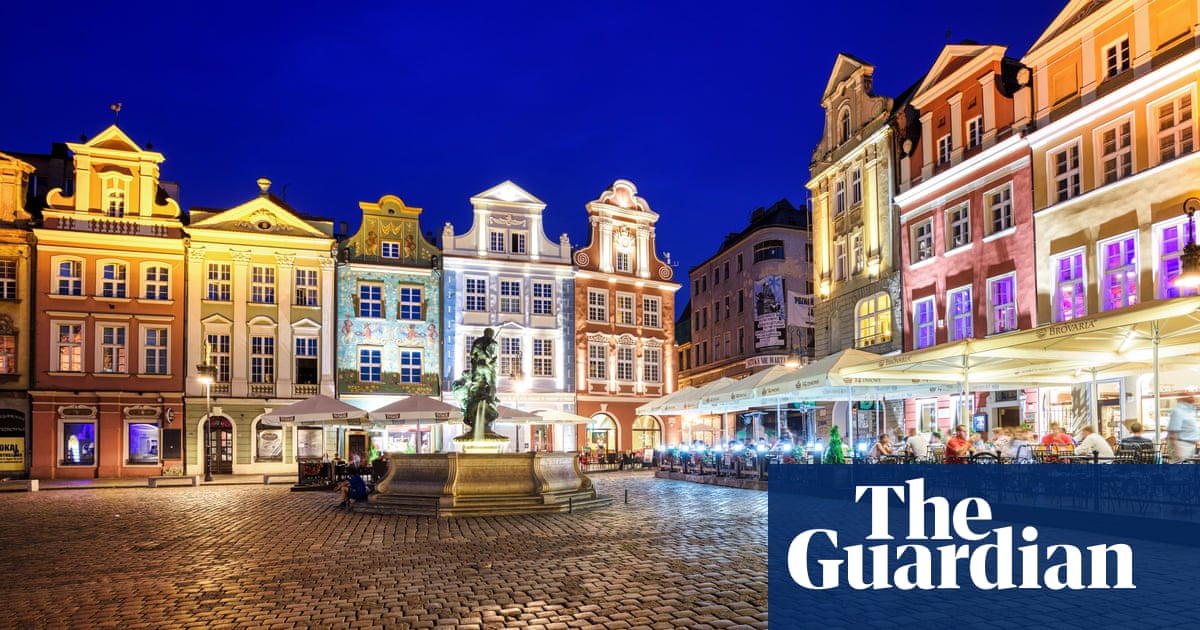
Poznań
I have a massive soft spot for Poznań, not least because I used to work in a fish and chip shop in the city. Poznań’s virtues include its vibrant old town; its lakes; its dancing goats (two mechanical billies make an appearance daily at noon atop the town hall, butting heads 12 times to mark the time); its Rogalowe (croissant) Museum (the city’s sweet treat is the St Martin’s croissant, filled with white poppy seeds); and the Enigma Cipher Centre (which sheds light on the vital role Polish codebreakers played in hampering the Nazis).
For memorable dining experiences, Concordia Taste does a two-course set lunch inspired by a different region of Poland each week (£8), and 62 Bar and Restaurant offers souped-up local classics on the roof of a Harley Davidson showroom (mains from £10).
For accommodation, the Andersia (doubles from €80 room-only) has a great view and a good breakfast.
Warsaw
Warsaw had been blitzed by the end of the second world war, so the fact that it is now a buoyant metropolis of two million people and came top in Europe’s Best Destination poll in 2023 is a bit of a miracle.
For a good-looking lesson in modern Polish history paired with an introduction to the science of illumination, head to the Neon Museum, a great collection of cold war-era neon signs.
For an introduction to the spirit that’s vital to Polish culture paired with an eye-opening half-hour trying a range of vodkas, head to the Museum of Vodka housed in a former vodka distillery. Gawp at the pickled heart of Chopin in the crypt of Holy Cross Church (really, is there nothing the Poles won’t pickle in a jar?) and then surrender to a 10-course tasting menu at Epoka, whose award-winning chef has developed modern interpretations of recipes stretching back to the 17th century, such as bigos (hunter’s stew) made with venison cheeks and served ramen style (menus from £83).
There’s a more down-to-earth culinary experience at Soul Kitchen, where the dumplings are lavish, the beef cheeks decadent, and the pavlova sublime (mains from £12).
For a memorable stay, the fashion-forward NYX Warsaw has doubles from €100 a night room-only.
Head for the hills
Poland has a belt of mountains on its southern border, perfect for skiing, hiking or wild swimming in alpine lakes. Wrocław in the south-west is a good base for the Karkonosze mountains, Kraków in the south for the Tatras, and Rzeszów in the south-east for the Bieszczady range. A friend of mine raved about her two-day solo hiking trip in the Tatras.
Ride the trams
Call me a dork, but there are few things I’d rather do with a spare couple of hours than ride a Polish tram. It appeals to the onlooker in me, and the eavesdropper, and the aesthete – and yes, the skinflint too. The number 16 in Poznań is my favourite, as it rounds the cathedral and crosses the Warta River, then skirts the old town and slips by the opera house, before pushing north through a thicket of towers in peach and pink to the university, where it pauses, turns round and goes again.
Go to a festival
For those seeking cutting-edge contemporary sounds in a post-industrial environment, there’s the New Music Festival in Katowice at the start of June. Röyksopp are this year’s headliners, and a three-day ticket costs about £65. Later in the month, the Open’er Festival takes place in the seaside town of Gdynia at the end of June with SZA headlining, and Arctic Monkeys and Lizzo also on the bill. A four-day camping ticket costs about £180. Lovers of independent cinema should check out the New Horizons film festival in Wrocław every July.
Find your religion
In Warsaw, St John’s cathedral is a gothic redbrick whopper and a testament to the nation’s devotion and fortitude (rebuilt many times, the latest after the German army blew it up in 1944). In Kraków, Wawel cathedral is a delightful bigos of architectural ingredients. Most gobsmacking of all, however, is St Kinga’s Chapel in the southern town of Wieliczka. Built 100 metres underground and made of salt, it’s a genuine marvel, and evidence, were it required, that the Poles will always find a way to pray – even if they’re engaged in hard labour down a salt mine.
Polish Riviera
Poles aren’t afraid of comparisons: Sopot is the gateway to the Polish Riviera, Wrocław is the Polish Venice, Warsaw the Polish Berlin, and Konstancin-Jeziorna, a suburban summer resort south of Warsaw, the Polish Beverly Hills. Sopot is Poland’s premier beach resort, with several miles of golden beach backed by protected dunes, the longest pier in Europe and restored spa-era architecture. It’s just a few miles away from the historic city of Gdańsk. Here, along with an impressively rectified old town, there is the magnificent European Solidarity Centre to investigate. The centre tells how Poland finally got the Communist monkey off its back.
Eat!
Given a spare afternoon in Poland, I’d find a nice little milk bar (bar mleczny), briefly soak up the timeless (and somewhat starchy) canteen atmosphere, then set about stuffing my face.
I’d begin with a gołąbki, a kind of Polish burrito – mince and rice rolled in cabbage and decked with tomato sauce. Then I’d have a bowl of soup, probably żurek (sour rye), which was recently voted the second-best soup in the world, probably for being deliciously sour and smoky and sweet all at once. Then I’d have a portion of the national stew, bigos, which is a slow-cooked riot of cabbage, onion, carrot, apple, smoked bacon, spices, mushroom, sausage, tomato, wine and whatever else is around. (Bigos sometimes translates as “mess”.)
I’d somehow find space for bread and smalec ( dripping), but I won’t bother with pierogi: for me Poland’s beloved dumplings are one of for the most overrated things in the northern hemisphere. For pudding, seeing as you asked, I’d have a wedge of sernik (cheesecake). Smacznego!
Masurian lake district
As well as healthy hikes, this is the place to rent a kayak or canoe to glide about on any one of the 2,000 lakes in one of Poland’s most remote regions, in the north-east of the country. Further east is the Białowieża forest, a vast primeval woodland that straddles the Polish-Belarus border. As well as black storks and wolves, the forest is home to hundreds of bison (keep your distance).The city of Białystok – home of Ludwik Lejzer Zamenhof, the inventor of Esperanto – is a suitable base. Tour operator Wild Poland has more inspiration along Poland’s eastern front.
Culture
Any trip to Poland is improved by a visit to Łódź – or HollyŁódź as it’s known to some. (Roughly speaking, Łódź is pronounced “woodge”, hence the hopeful conjunction.) The Polish Film School is based in the city, and it was here thatthe likes of Andrzej Wajda and Roman Polanski and Krzysztof Kieślowski cut their teeth. Manufaktura is an impressive art and leisure complex in an old textile factory, and a thought provoking hour can be spent at Muzeum Sztuki, a prestigious modern and contemporary art gallery.












